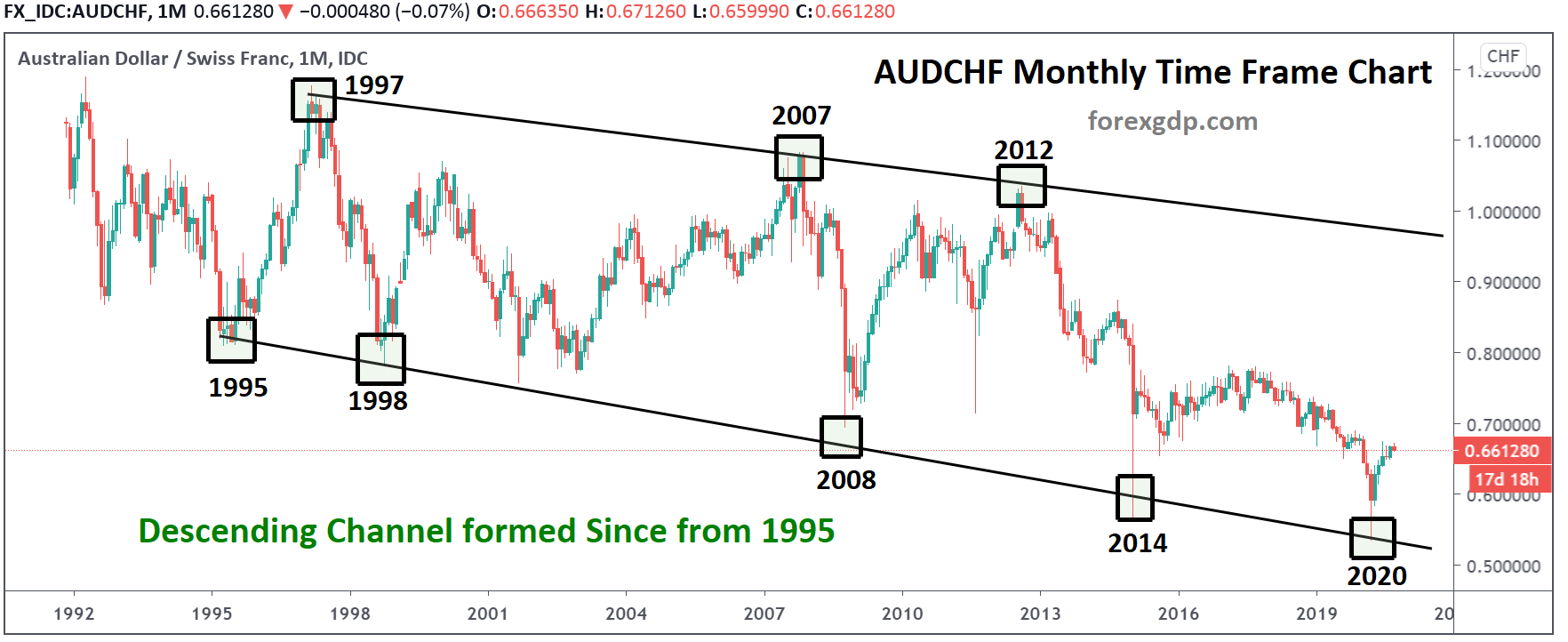Introducing AUDCHF
The AUDCHF currency pair is a combination of the Australian Dollar and the Swiss Franc. The AUD belongs to Australia while the CHF belongs to Switzerland. Both these individual nations are quite different from each other in all aspects including region and economic correlations. The Australian Dollar is the seventh most popular currency while the Swiss Franc is the tenth most popular currency. Both of these countries are G8 members, which explains their popularity. The G8 countries are the world’s top eight most prosperous or civilized nations. Because of their domestic economy, they are highly valued. The AUDCHF currency combination is the eleventh most popular minor currency pair in the forex business. Despite its popularity, it is still seen as a tiny currency pair due to the absence of the USD, which is why it is sometimes referred to as a cross-currency pair. To comprehend how this currency pair interacts, we must first understand who they are as individuals. Let’s learn about AUD and CHF.
The Australian Dollar
The Australian Dollar, abbreviated as AUD, is the national currency of Australia. It is the seventh most popular currency in the world. This means that this currency pair is quite popular in terms of the trading volume. This currency accounts for approximately 5.3 percent of all daily transactions in the forex space.
In the currency market, it is denoted by the sign AUD. Australia is well-known for its exports of precious metals and energy. The most popular commodity it exports is gold, while the most popular energy resource it exports is oil. Since 1825, Australia has solely utilized British coinage as its official currency. They began using genuine Australian Pound notes in 1910. However, in 1966, it changed its currency to the Australian Dollar in order to enhance relations with the United States. The Reserve Bank of Australia is in charge of printing AUD notes.
The Swiss Franc
Both Switzerland and Lichtenstein use the Swiss Franc as their national currency. It is one of the few currencies that has not been kicked out of the EU as a result of the formation of the Euro. Switzerland desired to maintain its own currency, the CHF. In terms of trading volume, the Swiss franc is the tenth most popular currency.
It accounts for 1% of the industry’s daily trading volume. It is also the fifth most frequently held reserve currency in the world. The Swiss National Bank is in charge of producing Swiss Franc notes. Switzerland is a preferred location for asset holdings since its private banking system is regarded as one of the best in the world. It is also a preferred holding spot as Switzerland is said to have one of the most stable economies in the world.
Why Trade AUDCHF
Both AUD and CHF belong to nations that are completely uncorrelated to each other. This may make some traders wonder whether this pair is even tradable. Here are the top reasons to trade the AUDCHF currency pair:
Commodity Correlations
The correlations between currency pairs like the AUDCHF and other assets in the market are a great reason to trade them. This is evident in the case of the Australian Dollar, which has strong correlations with commodities such as metals and energy. Gold and silver are two of their most popular metal exports.
Similarly, crude oil is their most popular energy export. It is especially evident in the instance of the Swiss franc, which has strong linkages with goods such as medicines and watches. This is due to their involvement in the exportation of these valuable products. As a result, trading this pair becomes even easier since if we understand the direction of the commodities market, we can easily grasp the direction of the AUDCHF market as well. We’ll go over how these commodities will affect the movement of the AUDCHF currency pair in greater detail later.
Market Predictability
Forecasting market conditions for the AUDCHF is rather simple. This is owing to the fact that changes in their respective nations, Australia and Switzerland, have the greatest effect on them. Because the USD is the main currency for worldwide commerce, any changes anywhere in the globe would affect a pair that included the USD. Similarly, any changes in any of the European Union’s 28 member countries would have an effect on a pair including the Euro. As a result, it becomes impossible to keep track of every place that may have an influence on a currency pair. Forex pairings that are merely related to a certain area, such as AUDCHF, are significantly easier to anticipate since we just need to look at their own countries and not the entire world.
Market Volatility
Despite being a minor currency pair, the AUDCHF is lucky to be able to trade under highly volatile conditions. In reality, the fact that they are a minor currency pair is what causes their instability in the first place. Because of its limited trading volume, the AUDCHF is classified as a minor currency. Because there aren’t as many traders participating at the same time, forex pairs with low trading volumes typically have significantly more volatility. They have a low trading volume since traders prefer to deal in the USD market using forex pairs that include the USD.
AUDCHF Trading Tips
Since the AUD and CHF are quite different from each other, they require some pretty solid strategies in order to be able to be traded successfully as a pair. Here are the top trading strategies for the AUDCHF currency pair:
Trade Timings
The foreign exchange markets are available round the clock, 24 hours a day, five days a week. Despite this, it is a widespread misunderstanding that you must devote all of your time to trading. That can be incredibly demanding, as well as unproductive. Instead, since their unique economies are awake and operating, each currency pair has particular periods of the day when they are the most active. It is only during certain periods that these currency pairings should be traded. During the Sydney and Tokyo sessions, the AUD is most active. Similarly, during the New York session, the CHF is most active. As a result, between 1 pm and 5:30 pm GMT is the ideal time to trade the AUDCHF currency pair.
Day Trading
Day trading is a trading strategy that involves opening and closing a deal on the same day. All transactions, whether profitable or not, must be completed before the market closes. Scalping is a common day trading strategy. Traders would open a BUY and SELL position for the same currency pair at the same rate. This allows them to profit no matter which way the market swings. When the market drops, they benefit from the opposing position they took. Because the AUDCHF dynamic pair may be fairly volatile at times, this approach is well suited for it. Scalping is a good strategy for profiting on fluctuating market rates during times of volatility.
Swing Trading
Swing trading signifies keeping an asset for one or more days in order to profit from price movements. AUDCHF is typically identified by price volatility that build well-defined ranges over extended time periods. As a result, the pair lends itself well to swing trading. Swing trading the AUDCHF currency pair includes deciding on a range within which the pair’s movement will be limited. After determining the price range, you might sell when the price reaches the top of the range and buy when the price reaches the bottom of the range.
Factors Affecting AUDCHF
Australia and Switzerland are impacted by some factors that are unique to their individual nations. Here are the top factors impacting the AUDCHF currency pair:
The Tourism Sector
Switzerland is one of the most popular tourist destinations in the world. Any changes in the amount of visitors entering Switzerland will have a significant impact on the CHF currency’s value. During the holiday season, more visitors visit Switzerland, increasing the value of the CHF and causing the AUDCHF to fall in value. Similarly, when it is not the vacation season, fewer visitors visit the nation, causing CHF to fall in value and, as a result, AUDCHF starts to climb in value.
The Crude Oil Industry
Australia is one of the world’s top crude oil exporters. They account for a sizable portion of the world’s oil supply. As a result, any change in global demand for crude oil will have a considerable influence on Australia’s exports and, by extension, the Australian economy.
An increase in demand for crude oil would drive the AUD to rise in value, causing the AUDCHF currency pair to rise in value as well. Similarly, a decline in demand for crude oil would cause the AUD to fall in value, causing the AUDCHF currency pair to fall in value as well.
The Pharmaceutical Industry
Switzerland is one of the world’s leading exporters of pharmaceutical items. These mostly consist of medications, although other pharmaceutical goods are also included. Any changes in demand for these items have a significant impact on the value of Switzerland’s economy. If the global demand for medications and other pharmaceuticals rises, Switzerland will be able to export them more often, increasing the value of the CHF. As a result, the value of the AUDCHF currency pair would fall. Similarly, if global demand for medications and other pharmaceuticals declines, Switzerland will be unable to export them as much as normal, causing the CHF to lose value. As a result, the value of the AUDCHF currency pair would rise.
The Gold Industry
Australia is the world’s third-largest gold exporter. As a result, its economy is heavily reliant on the export of this yellow metal in order to flourish and grow in value. Changes in the market conditions for this valuable commodity, such as supply and demand, will have an immediate influence on the AUDCHF pair. If the demand for gold rises, Australia will export more gold, causing the AUDCHF currency pair to rise. If gold demand falls, Australia suffers since it will be unable to export as much of it, causing the AUDCHF to fall in value. This is likely to be witnessed during the Asian festival season, when demand for gold rises. The AUDCHF rises during this season.
The Watch Industry
Switzerland is also well-known for the production and exportation of watches. They manufacture some of the world’s highest-quality timepieces. Their timepieces are highly popular abroad, and hence account for a significant portion of their exports. Any changes in demand for these items have a significant impact on the value of Switzerland’s economy. If the global demand for watches grows, Switzerland will be able to export them more often, increasing the value of the CHF. As a result, the value of the AUDCHF currency pair would fall. Similarly, if global demand for watches declines, Switzerland will be unable to export them as much as normal, causing the CHF to lose value. As a result, the value of the AUDCHF currency pair would rise.
Unemployment Rate
The unemployment rate has a significant impact on the value of the AUDCHF currency pair. This is especially true for the CHF, as Switzerland is well-known for its exceptionally low unemployment rate. Switzerland has one of the most stable economy’s in the world. Any changes in the number of citizens employed in a nation will have an influence on the country’s economy. This is due to the fact that the more individuals who are jobless, the more the state must provide for them from its own funds. This diminishes the worth of a country’s economy considerably. If the unemployment rate in Switzerland rises, the CHF will fall in value, causing the AUDCHF currency pair to rise in value. Similarly, if Australia’s unemployment rate rises, the value of the Australian dollar falls, causing the AUDCHF currency pair to fall as well.
Financial Institutions
Both the Reserve Bank of Australia and the Swiss National Bank are majorly responsible for any instability in the AUDCHF marketplace.
The RBA and SNB release monthly reports and statements regarding updates to any policy changes. These reports also display the economic and monetary forecasts for the upcoming short-term. Any positive results from the RBA will have a positive impact on the AUDCHF currency pair. However, any positive results from the SNB will have an inverse impact on the AUDCHF currency pair. The representatives of these individual banks also hold speeches frequently where they explain these results in more detail. These speeches are just, if not more, important in determining the direction of the AUDCHF market. From RBA, Philip Lowe who is the Governor of the institution is highly looked upon for his speeches. From SNB, Thomas Jordan who is the Governor of the institution is highly looked upon for his speeches.
Most common questions asked by the forex traders about AUDCHF:
Forex GDP, Babypips, Tradingview, Forexfactory.
AUDCHF Trading Signals
Check Full Forex Market Signals with Technical Analysis Chart
Please note : It is better to do nothing instead of taking wrong trades, we focus on providing you the forex signals only at good trade setup.
Each trade signal given to you with fundamental and technical analysis chart which helps you to understand why our analyst team has given the Buy signals and Sell Signals. Now, you can trade with confident using our service. Sounds good? Let’s look out all our signal charts below.
If you want to test our forex signals, Try free plan (or) if you need more forex signals, Join here for Premium or Supreme plan
Check all our signal results and some of the subscriber’s Myfxbook results here. Try our free service now, let the results speak the rest.

Trump and Biden’s Poll – Forex Trade Setups to Watch
EURUSD Analysis EURUSD reached the top zone (lower high) of the descending channel. Inflation data for September month will put

Descending channel movement Since from 1995 in AUDCHF
AUDCHF Historical Analysis AUDCHF is moving in a descending channel since from the year 1995 to till now in 2020.





